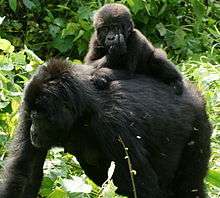Eastern gorilla
| Eastern gorilla[1] | |
|---|---|
 | |
| Male | |
 | |
| Female with infant | |
| Scientific classification | |
| Kingdom: | Animalia |
| Phylum: | Chordata |
| Class: | Mammalia |
| Order: | Primates |
| Suborder: | Haplorhini |
| Family: | Hominidae |
| Genus: | Gorilla |
| Species: | G. beringei |
| Binomial name | |
| Gorilla beringei Matschie, 1903 | |
| Subspecies | |
 | |
| Eastern gorilla range | |
The eastern gorilla (Gorilla beringei) is a critically endangered species of the genus Gorilla and the largest living primate. At present, the species is subdivided into two subspecies. Grauer's gorilla, formerly known as the eastern lowland gorilla (G. b. graueri) is more populous, at about 3,800 individuals.[3] The mountain gorilla (G. b. beringei) has only about 880 individuals. The International Union for the Conservation of Nature mentioned illegal hunting in its assessment of threats to the species.[4][5]
Taxonomy and phylogeny
There are two recognised subspecies of eastern gorilla: the mountain gorilla (Gorilla beringei beringei) of the volcanic slopes of Rwanda, Uganda and eastern Democratic Republic of Congo; and Grauer's gorilla or eastern lowland gorilla (Gorilla beringei graueri) in eastern Democratic Republic of Congo.
Grauer's gorillas and mountain gorillas were previously thought to be two of the three subspecies of one single species, the gorilla (Gorilla gorilla). However, genetic research has shown that the two eastern subspecies are far more closely related than the western subspecies: the western lowland gorilla (G. gorilla gorilla), which justified the separate classification.[6] The two eastern subspecies are now classified as G. beringei.
Physical description
The eastern gorilla is a large hominid with a large head, broad chest, and long arms. It has a flat nose with large nostrils. The face, hands, feet and breast are bald. The fur is mainly black, but adult males have a silvery "saddle" on their back. When the gorilla gets older, the hair on the saddle of the back becomes white, much like the gray hair of elderly people. This is why the older males are called silverbacks. Grauer's gorilla has a shorter, thicker, deep black fur, while the mountain gorilla has a more bluish color. The mountain gorilla is slightly smaller and lighter than Grauer's gorilla, but still larger and heavier than the western lowland gorilla and the Cross River gorilla. Males are much larger than females. A full-grown adult male Eastern gorilla typically weighs 140–205.5 kg (309–453 lb) and stands 1.7 m (5.6 ft) upright and a female typically weighs 90–100 kg (200–220 lb) and stands 1.5 m (4.9 ft) tall.[7][8] The tallest silverback recorded was a 1.94-metre (6.4 ft) individual shot in Alimbongo, northern Kivu in May 1938. The heaviest gorilla recorded was a 1.83-metre (6.0 ft) silverback shot in Ambam, Cameroon which weighed about 266 kilograms (586 lb),[9] although the latter area is within the range of the western gorilla, far outside that of the eastern gorilla.
Distribution and ecology
Mountain gorillas are restricted to the mountain rainforests and subalpine forests of eastern Democratic Republic of the Congo, southwestern Uganda and Rwanda. Grauer's gorilla occur across the forests of the Albertine Rift in eastern DRC.
Eastern gorillas are herbivorous, with a heavily foliage based diet, due to lack of available fruit in their habitats. They have smaller home ranges than western gorillas as foliage is more abundant than fruit. They are diurnal but the majority of foraging occurs in the morning and late afternoon. At night they build nests by folding over vegetation, usually on the ground.
Behavior
Eastern gorillas live in stable, cohesive family groups, led by a dominant silverback male. Eastern gorillas tend to have larger group sizes than their western relatives, numbering up to 35 individuals. There is no distinct breeding season and females give birth only once every 3-4 years due to the long period of parental care and a gestation period of 8.5 months. Newborn gorillas have greyish-pink skin and can crawl after 9 weeks; they are not fully weaned until 3.5 years. Males defend their females and offspring using their large size in intimidating displays involving charging and chest-beating.
Conservation status
The eastern gorilla has become increasingly endangered since the 1990s, and the species was listed as critically endangered in September 2016 as its population continued to decrease. Illegal hunting for bushmeat and destruction of their habitat as a result of intensifying forestry and the development of agriculture form the most important threats for the species. Between 1996 and 2016, the eastern gorilla lost more than 70 percent of its population, and by 2016 the total population was estimated to be less than 6,000.[5]
The only exception is the mountain gorilla subspecies, which is also critically endangered but saw its population increase to about 880 individuals in 2016. In some national parks, viewing mountain gorillas is a popular tourist attraction. These national parks include Volcanoes National Park in Rwanda, Virunga National Park in the Democratic Republic of the Congo, and Mgahinga Gorilla National Park and Bwindi Impenetrable National Park in Uganda. This has both advantages (environmental awareness, financial benefit) and disadvantages (disease risks, disturbance of natural behavior) for the conservation of the gorillas.
Unlike the western lowland gorilla, there are few eastern gorillas in zoos. The Antwerp Zoo is the only zoo outside the native range of the species that has eastern lowland gorillas. Outside the native range, the mountain gorilla is not held in captivity at all.[10] Small groups consisting of animals confiscated from poachers are kept in the Democratic Republic of Congo: Grauer's gorillas at the Gorilla Rehabilitation and Conservation Education (GRACE) center in Tayna Nature Reserve,[11] and mountain gorillas at the Senkwekwe Center in Virunga National Park.[12]
References
- ↑ Groves, C.P. (2005). Wilson, D.E.; Reeder, D.M., eds. Mammal Species of the World: A Taxonomic and Geographic Reference (3rd ed.). Baltimore: Johns Hopkins University Press. pp. 181–182. OCLC 62265494. ISBN 0-801-88221-4.
- ↑ Plumptre, A.; Robbins, M.; Williamson, E. A. (2016). "Gorilla beringei". IUCN Red List of Threatened Species. IUCN. 2016: e.T39994A17964126. Retrieved 5 September 2016.
- ↑ "Gorillas on Thin Ice". United Nations Environment Programme. 15 January 2009. Retrieved 19 May 2010.: "The Eastern Lowland Gorilla population in the DRC has plummeted dramatically over the last 10 years, with probably only about 5,000 of the formerly 17,000 animals remaining."
- ↑ "The Eastern Gorilla listed on Red List of Endangered Species by IUCN". CBSnews. AP. September 4, 2016. Retrieved September 4, 2016.
- 1 2 "Four out of six great apes one step away from extinction – IUCN Red List". 4 September 2016.
- ↑ Taylor, Andrea Beth; Goldsmith, Michele Lynn (2003). Gorilla biology: a multidisciplinary perspective. Cambridge University Press. p. 13. ISBN 978-0-521-79281-3.
- ↑ Williamson, E.A. and Butynski, T.M. (2013) Gorilla gorilla. In: Butynski, T.M. (Ed) The Mammals of Africa Volume 6. Elsevier Press
- ↑ Burnie D and Wilson DE (Eds.), Animal: The Definitive Visual Guide to the World's Wildlife. DK Adult (2005), ISBN 0789477645
- ↑ Wood, The Guinness Book of Animal Facts and Feats. Sterling Pub Co Inc (1983), ISBN 978-0-85112-235-9
- ↑ Fossey, Dian (2000). Gorillas in the Mist. Houghton Mifflin Books. ISBN 0-618-08360-X.
- ↑ The Dian Fossey Gorilla Fund: The GRACE Center for Rescued Gorillas. Retrieved 16 August 2013
- ↑ Senkwekwe Orphan Mountain Gorilla Center. Retrieved 16 August 2013
External links
| Wikimedia Commons has media related to Gorilla beringei. |

